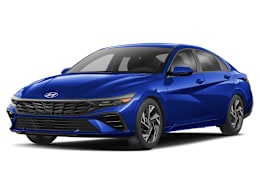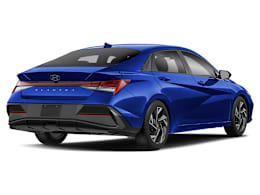The latest version of the Elantra feels like a more grown-up car than the model it replaces. It has a sleek and easy-to-use infotainment system, a well-tuned transmission, gets impressive fuel economy, and has a relatively roomy interior for the class. The hybrid version is the best choice, not only for its superb fuel economy, but its better ride and handling.
The standard 147-horsepower, 2.0-liter four-cylinder engine, though noisy when pushed, gets off the line smoothly and delivers enough power and speed to be considered “brisk” by class standards. We’re particularly impressed by the continuously variable transmission (CVT), which nearly mimics the shifts and operation of a traditional automatic. In fact, we think most buyers won’t even realize that it’s anything other than a regular automatic, because it rarely displays the annoying CVT tendency where engine revs seem disproportionately high compared with the car’s acceleration.
Fuel economy is among the best in the compact class, at 33 mpg overall in our testing, let alone the hybrid with its 48 mpg overall.
Handling is quite nimble and predictable, although the steering is on the light side and is short on feedback. The car proved capable and secure when taken to the limits, both on our road-course test track and through our avoidance maneuver exercise, which simulates swerving suddenly to avoid a vehicle or obstacle on the road.
The ride is about average, which is to say it’s quite firm but not harsh—its suspension doesn’t absorb bumps nearly as well as the class standouts, the Subaru Impreza and Toyota Corolla. The cabin can get loud, with noticeable road noise, and the engine sounds boisterous when pushed hard.
As with most sedans, the Elantra sits low to the ground, which makes it feel like you’re dropping down into the front seats when you get in. The driver has decent room, but we found that the seat loses support on longer trips. The uplevel Limited trim comes with a power seat that includes adjustable lumbar support. The rear seat, although relatively roomy for the class, is even more difficult to access, because the car’s sloping roofline forces occupants to duck significantly.
The configurable digital instrument panel is easy to use, as is the standard 8-inch infotainment touch screen that appears as though it’s an extension of the instrument panel. The infotainment screen has large icons that are simple to decipher, and it features wireless Android Auto and Apple CarPlay connectivity. SEL versions and above get a larger 10.25-inch system, but it loses wireless CarPlay and Android Auto.
The Elantra comes with an impressive roster of standard advanced safety and driver assistance features, including forward collision warning, automatic emergency braking with pedestrian detection, blind spot warning, rear cross traffic warning, lane departure warning, lane keeping assistance, lane centering assistance, and adaptive cruise control.
Overall, we think the hybrid version is best for most consumers. It has much better fuel mileage and offers a smoother ride and quieter cabin.




















